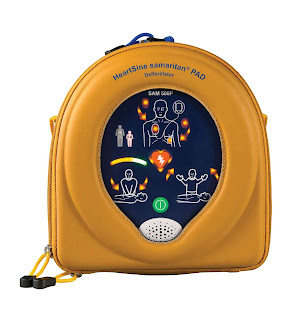Defibrillators 101: Understanding the Key Features of the Heartsine Defibrillator
The Heartsine Defibrillator is a portable medical device that can help save lives in the event of cardiac arrest. It's easy to use and has several features that make it dependable.
In this post, we'll examine these features so you know exactly what you're getting when you purchase a Heartsine.
Introduction
The Heartsine Defibrillators are reliable and easy-to-use AED. It's the only AED that offers a preference key, which allows you to customise your device for your specific needs. The oral readout unit (ORU) provides clear instructions on how to operate the device, making it ideal for those with little or no experience using an AED.
AED
AED is an acronym for Automated External Defibrillator. AEDs are portable devices that can be used to treat a patient who is in cardiac arrest and experiencing ventricular fibrillation, the most common type of heart rhythm disturbance. They are typically found in public places such as airports, sports stadiums, and shopping malls.
When a patient has been diagnosed with ventricular fibrillation (VF) by a healthcare professional using an ECG monitor, they will then need to be treated with an electric shock before their condition deteriorates further into asystole - when no electrical activity occurs within the heart at all - or pulseless electrical activity (PEA), where there is some electrical activity but it's not enough to keep blood circulating through your body properly.
Algorithm
The algorithm is the program that determines how the device will respond to a shock. It's a computer program that runs on the defibrillator, and it's designed to detect when a shock is needed and when it is not.
The Heartsine S-ICD contains two algorithms: one for patients with ICDs (implantable cardioverter-defibrillators), and another for those without ICDs.
Preference Key
The Preference key allows you to choose between two different modes. In addition, it allows you to select different settings for each mode. This feature can be used to change your settings during use if necessary.
Oral Readout Unit (ORU)
The Oral Readout Unit (ORU) is a display that shows the patient's ECG and other vital signs, such as heart rate and blood pressure. The ORU is used to analyse the patient's ECG and determine if a shock is necessary. It can also be used to confirm that a shock was delivered correctly by measuring its effects on the patient's heart rhythm.
Safety Features
The Heartsine Defibrillator is equipped with several safety features that ensure you and your patient are protected. These include:
- A visual and audible warning when the device is turned on, as well as another visual and audible warning when it's about to deliver a shock.
- An additional visual and audible warning when the device is in its charging station, so you know where it's located at all times (and if anyone tries to move it).
Conclusion
In conclusion, we hope that this guide has provided you with a better understanding of what to look for when purchasing a defibrillator. Remember that there are many different types of devices available on the market today, so make sure you research all your options of heartsine defibrillator before making any decisions!


Comments
Post a Comment